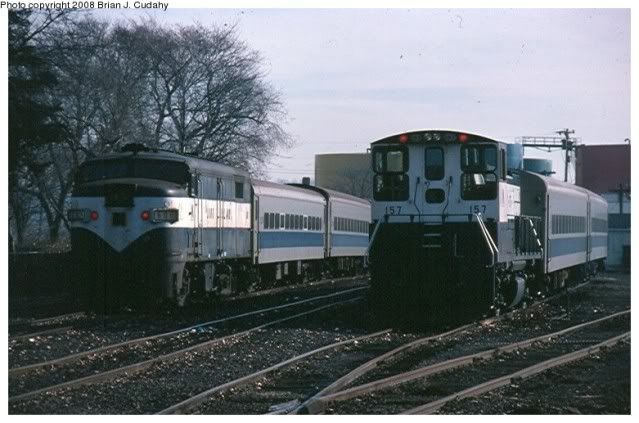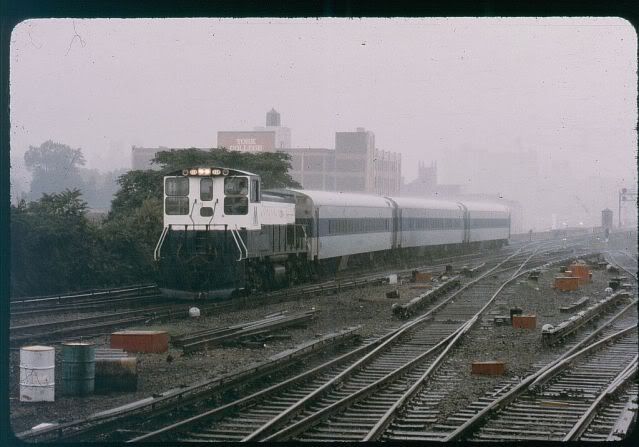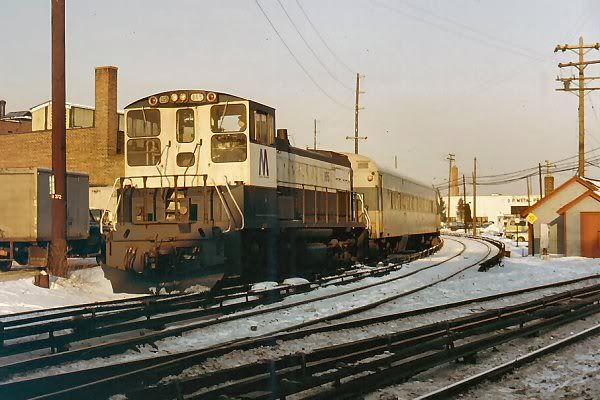keyboardkat wrote:But with the Alco C420s, the last steam-equipped passenger diesels on the LIRR, the BLE insisted that the long hood be on the front because they said that, if the short hood was in front, in the event of a collision, the engineers would be in danger of scalding from the steam generator in the short hood, regardless of whatever other damage or injuries resulted.That's a pretty good reason, too.
Railroad Forums
Why MP15's for passenger power?
- Discussion of the past and present operations of the Long Island Rail Road.
Moderator: Liquidcamphor
I miss any reliable engine on the LIRR.
These days, the LIRR has made it easy for me to decide to DRIVE in from now on when I need to head into the city. Between there lack of reliability and schedule cuts, I'll drive.
More on point, I enjoyed seeing the 1500 and Geeps in action.
I have some video of one particualr train in Oyster Bay with 3 Mp15acs being used.
Occurred in the late 90s as the new fleet was being ushered in.
These days, the LIRR has made it easy for me to decide to DRIVE in from now on when I need to head into the city. Between there lack of reliability and schedule cuts, I'll drive.
More on point, I enjoyed seeing the 1500 and Geeps in action.
I have some video of one particualr train in Oyster Bay with 3 Mp15acs being used.
Occurred in the late 90s as the new fleet was being ushered in.
All you need is faith
To hear the diesels humming
To hear the diesels humming
There was no restriction or rule prohibiting running a GP38 backwards on the LIRR in any class of service. Nothing in the BLE contract states that they "shall not be operated backwards". What it does say is that if a GP38 was scheduled to be used on a passenger train long hood forward, another engineer would be called out to spot you during the ride. And that only meant that if it was setup in the yard deliberately long hood forward. If this was not the case and the engine was backwards, you ran it and lived with it.
It did not mean that they had to call out another engineer if you ran around the train and having the engine backwards for mechanical reasons, turning the engine where there was no wye, thrills and excitement, photo ops for excited railbuffs, etc.
The engine that was frowned upon running backwards in passenger service was the E15's because of little protection in the event of a collision. The Oyster Bay train (I think 507/562) that had two E15's, had so for this reason. It was actually scheduled to have one E15, which would run long hood forward from LIC to OB. Then run around in OB, to come west short hood forward. The long time engineer who later became the GC of the BLE, made such a issue about the lack of protection in a 65mph collision, that the railroad added another E15 to quiet him down. After this change, on Fridays in the summer during engine shortages, it was common to have one E15 and either another was brought out over the weekend to double head it for the Monday trip, or it was run backwards.
It did not mean that they had to call out another engineer if you ran around the train and having the engine backwards for mechanical reasons, turning the engine where there was no wye, thrills and excitement, photo ops for excited railbuffs, etc.
The engine that was frowned upon running backwards in passenger service was the E15's because of little protection in the event of a collision. The Oyster Bay train (I think 507/562) that had two E15's, had so for this reason. It was actually scheduled to have one E15, which would run long hood forward from LIC to OB. Then run around in OB, to come west short hood forward. The long time engineer who later became the GC of the BLE, made such a issue about the lack of protection in a 65mph collision, that the railroad added another E15 to quiet him down. After this change, on Fridays in the summer during engine shortages, it was common to have one E15 and either another was brought out over the weekend to double head it for the Monday trip, or it was run backwards.
Back to the original post in this thread, whatever the reaosn was for ordering MP15's was likely a continuation of why there was previously RS-3's.
What it does say is that if a GP38 was scheduled to be used on a passenger train long hood forward, another engineer would be called out to spot you during the ride.Was there ever a time a Geep was scheduled to be long hood forward?
And that only meant that if it was setup in the yard deliberately long hood forward.Again, any reason it would be done deliberately? Was it something engineer's could request, etc?
All you need is faith
To hear the diesels humming
To hear the diesels humming
just a quick note alot of those first and sec generations diesels supposedly were setup like steam with the long hood out. What the engineers were used to having in front of them.
Signed off
Was there ever a time a Geep was scheduled to be long hood forward?If the turntable was OOS and they couldn't be turned in Belmont/Snowstorms where everything was a mess/Engine shortages where they couldn't turn the engine in time to not delay the train, etc. As far as special requests? As long as it did not cost the Company any money, they didn't care what you did back then.
Again, any reason it would be done deliberately? Was it something engineer's could request, etc?
There were also the "Engine Backward" claims, where the Engineer received a days pay if the engine could not be turned. Many Oyster Bay trains with 2900's in the off peak hours just ran around the train. So, you could see the E15's run "B" end forward. The claim was eventually settled.
Hello all,
Interesting discussion, worth bringing back.
I always wondered how the dual MP15 configuration was possible in terms of head end power. I was not aware until some years later that some of the diesel-hauled coaches had generators. But, this is the first I've heard of the MP15s being able to run at notch 3 and generate 600 V DC. How exactly did that work? I knew there had to be a way, even though others had assured me that I had to be mistaken about seeing a train without an FA or F-unit power pack.
I agree that the dual MP15s seemed to be most frequent on the Oyster Bay Branch, but I had seen them on the other services mentioned (Greenport and Babylon-Patchogue). One trip I took to Montauk had a GP38-2 and FA for the outbound trip, but when we boarded at East Hampton for the return trip, the power was two back-to-back MP15s on the head end. I thought this arrangement was unusual, not only because it appeared on a Montauk train, but also because I had always seen the MP15s bracketing the ends of the train on the Oyster Bay Branch. And, by the way, that train -screamed- into the East Hampton station, then stopped very short, with sparks flying from the cast iron brake shoes -- quite a show!
During the summer of 1984, when I regularly traveled on an early morning outbound to Republic, I recall passing the Oyster Bay train sitting in the pocket at Queens Village every morning. It occasionally had a GP38-2 and FA or F-unit, but usually had an MP15 on each end of the 4-car train.
Cheers,
Al "dlandw"
Interesting discussion, worth bringing back.
I always wondered how the dual MP15 configuration was possible in terms of head end power. I was not aware until some years later that some of the diesel-hauled coaches had generators. But, this is the first I've heard of the MP15s being able to run at notch 3 and generate 600 V DC. How exactly did that work? I knew there had to be a way, even though others had assured me that I had to be mistaken about seeing a train without an FA or F-unit power pack.
I agree that the dual MP15s seemed to be most frequent on the Oyster Bay Branch, but I had seen them on the other services mentioned (Greenport and Babylon-Patchogue). One trip I took to Montauk had a GP38-2 and FA for the outbound trip, but when we boarded at East Hampton for the return trip, the power was two back-to-back MP15s on the head end. I thought this arrangement was unusual, not only because it appeared on a Montauk train, but also because I had always seen the MP15s bracketing the ends of the train on the Oyster Bay Branch. And, by the way, that train -screamed- into the East Hampton station, then stopped very short, with sparks flying from the cast iron brake shoes -- quite a show!
During the summer of 1984, when I regularly traveled on an early morning outbound to Republic, I recall passing the Oyster Bay train sitting in the pocket at Queens Village every morning. It occasionally had a GP38-2 and FA or F-unit, but usually had an MP15 on each end of the 4-car train.
Cheers,
Al "dlandw"
dlandw wrote:Hello all,This has proven confusing for many who were not born yet or were not old enough to remember the LIRR's initial orders of P-72s and MP-72s. So here goes:
Interesting discussion, worth bringing back.
I always wondered how the dual MP15 configuration was possible in terms of head end power. I was not aware until some years later that some of the diesel-hauled coaches had generators. But, this is the first I've heard of the MP15s being able to run at notch 3 and generate 600 V DC. How exactly did that work? I knew there had to be a way, even though others had assured me that I had to be mistaken about seeing a train without an FA or F-unit power pack.
I agree that the dual MP15s seemed to be most frequent on the Oyster Bay Branch, but I had seen them on the other services mentioned (Greenport and Babylon-Patchogue). One trip I took to Montauk had a GP38-2 and FA for the outbound trip, but when we boarded at East Hampton for the return trip, the power was two back-to-back MP15s on the head end. I thought this arrangement was unusual, not only because it appeared on a Montauk train, but also because I had always seen the MP15s bracketing the ends of the train on the Oyster Bay Branch. And, by the way, that train -screamed- into the East Hampton station, then stopped very short, with sparks flying from the cast iron brake shoes -- quite a show!
During the summer of 1984, when I regularly traveled on an early morning outbound to Republic, I recall passing the Oyster Bay train sitting in the pocket at Queens Village every morning. It occasionally had a GP38-2 and FA or F-unit, but usually had an MP15 on each end of the 4-car train.
Cheers,
Al "dlandw"
The railroad ordered its fleet of "72" type air-conditioned cars in 1955 or so, of two general types: Electric MUs, which were equiped for 660 v.d.c third-rail operation, and locomotive-hauled coaches. The latter were equiped with steam heat, and had underbody diesel alternators to drive the air conditioning when it was in use, fluorescent lights, blower and water cooler. In the event of failure of the underbody diesel power pack, a jumper cable could be connected between cars (located above the vestibule doors between cars so that a trainman could connect it without getting off the train). But in such a case, the diesel power pack in one car could only supply enough juice to the adjacent car to power the lights and blower and water cooler, but not the air conditioner. The two types of cars had identical carbodies; hence the confusion in later years when the MUs were modified for diesel operation. The MUs were called MP-72s; the locomotiive-hauled cars were called P-72s.
During the mid '70s, with the arrival of the EMD GP-38s and MP-15s, which had no steam generators, the LIRR modified the P-72s by equiping the undercarbody power plants with larger alternators, producing 200 v. a.c., and replacing the steam heat equipment with electric heat. After this, the P-72s were completely self-contained as far as HEP was concerned, and could be hauled by anything.
Some of the MP-15s were modified to serve as HEP generator cab cars in push-pull service, with special engine speed controls, HEP jumper cables and a bypass switch. When set up as HEP cab cars, the prime mover idled at about notch 3 or 4, and the current produced was routed to the jumper cables, instead of to the traction motors. The throttle controlled the road locomotive at the opposite end in the "push" mode, but did not affect the engine RPM in the MP-15. These units could also serve as conventional locomotives, but not both at the same time.
Hope this clears things up a bit.
Fairbanks-Morse forever!
was very common to see mp-15's running short hood forward from oyster bay during the times the turntable was out of service.
Some Engineers even preferred running that way because of the better visability.
Lots of photos on line, at trainsarefun.com, or nycworldsubway.org of trains running short hood forward.
When I was on the roustabout, my Engineer preferred it that way whenever we could.



Some Engineers even preferred running that way because of the better visability.
Lots of photos on line, at trainsarefun.com, or nycworldsubway.org of trains running short hood forward.
When I was on the roustabout, my Engineer preferred it that way whenever we could.



The last photo shows the Oyster Bay line coming into the main with a building at the junction. I went past about a week ago and the building is no longer there.
Ray
Ray
The first picture of the FA and push pull cars.. If that pic was taken on a weekend back in the old days.. That would be train 4555. I used to clean that train and do the engrs winshield for him. The crew was a start out crew back in 1989. the crew was Bill Mathews engr Condr Pete Holachak Asst condr Joe Terrizi. The 157 had 6 Electric Heats plus Parlor car 2002(private)total 7 units.
I liked the old school equipment & motive power, but I wasn't a regular commuter then. I guess that's why I liked it.
Searching for the eagles of the XVII,XVIII & XIX Legions in Germania.
As ragtag and battle worn the old stuff was, It still had class. It was your typical American train.